
The Mystery of the Open Window is a 1929 mystery detective novel by Anthony Gilbert, the pen name of British writer Lucy Beatrice Malleson. It is the fourth novel in a series featuring her amateur detective, the politician Scott Egerton. Unlike the rest of the series it was published by Gollancz rather than Collins. It takes the form of a locked room mystery, a popular branch of the genre during the Golden Age of Detective Fiction.
Irish writer Alister McAllister [1877-1943] wrote several plays under the pseudonym Anthony Wharton and later, after moving to England, wrote a series of mystery novels using the pseudonym Lynn Brock.

The Slip-Carriage Mystery is a 1928 mystery detective novel by the Irish-born writer Lynn Brock. It was the fourth novel in his series featuring the character of Colonel Wyckham Gore. The previous novels in the series established Gore a popular character during the early stages of the Golden Age of Detective Fiction. A review in the Times Literary Supplement observed "The multiplication of false leads at the beginning is carried a little too far, and the story is at its best when the movement is greatest as it approaches and reaches its end".

The Deductions of Colonel Gore is a 1924 detective novel by the Irish-born writer Lynn Brock. It was the first in his series of seven novels featuring the character of Colonel Wyckham Gore. Gore enjoyed popularity during the early stages of the Golden Age of Detective Fiction. It was also published under the alternative title The Barrington Mystery.

Colonel Gore’s Second Case is a 1925 detective novel by the Irish writer Lynn Brock. It was the second in his series of seven novels featuring the character of Colonel Wyckham Gore. Gore enjoyed popularity during the early stages of the Golden Age of Detective Fiction. After solving his first case Gore now establishes his own detective agency.

The Kink is a 1927 mystery detective novel by the Irish-born writer Lynn Brock. It was the third novel in his series featuring the character of Colonel Wyckham Gore, one of many investigators active during the Golden Age of Detective Fiction. It is sometimes referred to as Colonel Gore’s Third Case. The novel is noted for being comparatively sexually explicit for the era. Dashiell Hammett wrote a contemporary negative review of the book in The Saturday Review.

The Stoat is a 1940 mystery detective novel by the Irish-born writer Lynn Brock. It was the seventh and last novel in his series featuring the character of the Golden Age detective Colonel Wyckham Gore. It was also his last published work before his death three years later. It marked a return for Gore, who hadn't appeared in a novel since 1930.

The Dagwort Coombe Murder is a 1929 mystery detective novel by the Irish-born writer Lynn Brock. It was the first stand-alone novel by Brock following the success of his Golden age detective Colonel Gore. It was published in the United States with the alternative title The Stoke Silver Case.
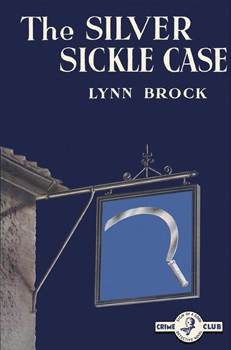
The Silver Sickle Case is a 1938 detective novel by the Irish-born writer Lynn Brock. Best known for his Colonel Gore series of mysteries, the novel introduced an alternative detective character Sergeant Venn of Scotland Yard assisted by Detective Constable Kither. It was followed by two sequels.

The Riddle of the Roost is a 1939 mystery detective novel by the Irish-born writer Lynn Brock. It was the third and last in his trilogy featuring the characters of Scotland Yard detective Sergeant Venn and Constable Kither. It was Brock's penultimate novel, followed the next year by The Stoat a final entry into the series of his best-known character Colonel Gore.

Lady Killer is a 1951 mystery thriller novel by Anthony Gilbert, the pen name of British writer Lucy Beatrice Malleson. It is the twenty fifth in her long-running series featuring the unscrupulous London solicitor Arthur Crook, one of the more unorthodox detectives of the Golden Age.
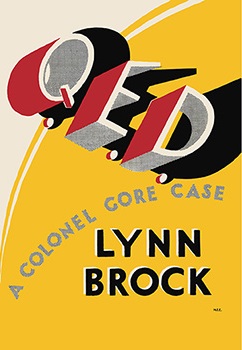
Q.E.D. is a 1930 mystery detective novel by the Irish-born writer Lynn Brock. It was the sixth of seven novels in his series featuring the character of Colonel Wyckham Gore, one of the most prominent investigators during the early stages of the Golden Age of Detective Fiction. It was published in the Under States with the alternative title of Murder on the Bridge.

Nightmare is a 1932 thriller novel by the Irish-born writer Lynn Brock. It is an inverted detective story, and a stand alone work for an author best known for his series featuring the Golden Age detective Colonel Gore.
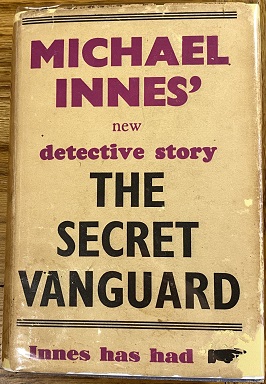
The Secret Vanguard is a 1940 thriller novel by the British writer Michael Innes. It is the fifth in his series featuring John Appleby, a young Detective Inspector in the Metropolitan Police. The novel takes place in the early stages of the Second World War, and functions closer to a mystery spy novel than the traditional detective novel.

Death at the President's Lodging is a 1936 detective novel by the British writer Michael Innes. It was the first in a series of novels featuring John Appleby, a Detective Inspector in the Metropolitan Police. It is a traditional closed circle of suspects mystery, taking place in a fictitious Oxbridge college located in Bletchley about halfway between Cambridge and Oxford on the Varsity Line. It was released in the United States by Dodd, Mead under the alternative title Seven Suspects.
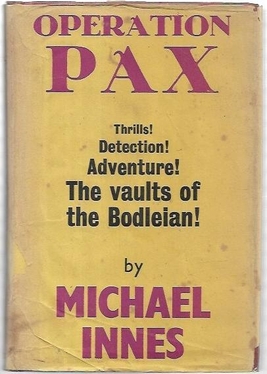
Operation Pax is a 1951 mystery thriller novel by the British writer Michael Innes. It is the twelfth entry in his series featuring John Appleby, a detective in the Metropolitan Police. The novel is thematically a thriller rather than the traditional Golden Age of Detective Fiction murder investigation that features in most of the series. As with other books in the series a farcical tone is often maintained. It was released in the United States under the alternative title The Paper Thunderbolt.

Lament for a Maker is a 1938 detective novel by the British writer Michael Innes. It is the third in his series featuring John Appleby, a young Detective Inspector in the Metropolitan Police. It was published during the Golden Age of Detective Fiction. The title refers to the Lament for the Makaris by the Scottish poet William Dunbar, which is constantly recited by one of the characters. The novel features a string of first person narratives of the events that takes place, which each character drawing a conclusion that builds on and also corrects the previous writer.
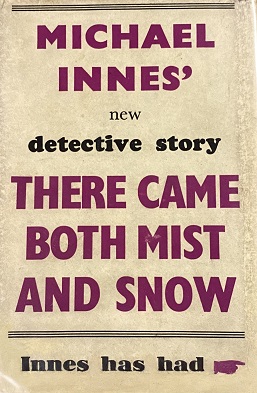
There Came Both Mist and Snow is a 1940 detective novel by the British writer Michael Innes. It is the sixth in his series featuring John Appleby, a Detective Inspector in the Metropolitan Police. The title is a reference to a line from The Rime of the Ancient Mariner by Samuel Taylor Coleridge. It is a country house mystery told in a first person narrative by Arthur Ferryman, one of the guests at a family gathering and witness to the events. It makes no mention of the ongoing Second World War. It was published in the United States by Dodd, Mead under the alternative title A Comedy of Terrors.
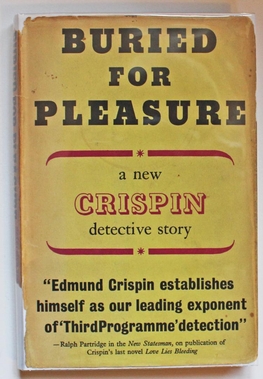
Buried for Pleasure is a 1948 detective novel by the British writer Edmund Crispin, the sixth in his series featuring the Oxford professor and amateur detective Gervase Fen. As with the rest of the Fen novels, a complex Golden Age-style mystery is combined with elements of farce. Fen contests a by-election in rural constituency, but events are rapidly overtaken by a murder case. It features Detective Inspector Humbleby who also appeared in the next novel Frequent Hearses as well as most of the short stories in the series.

Stop Press is a 1939 mystery detective novel by the British writer Michael Innes. It is the fourth in his series featuring John Appleby Detective Inspector of Scotland Yard. It was written during the Golden Age of Detective Fiction and was first published by Victor Gollancz and in America by Dodd Mead under the alternative title The Spider Strikes. A country house mystery, it is the only novel in the series in which Appleby's sister Patricia appears.



















